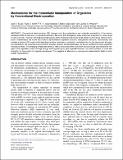| dc.contributor.author | Esser, Axel Thomas | |
| dc.contributor.author | Smith, Kyle C. | |
| dc.contributor.author | Gowrishankar, Thiruvallur R. | |
| dc.contributor.author | Vasilkoski, Zlatko | |
| dc.contributor.author | Weaver, James C. | |
| dc.date.accessioned | 2015-03-20T14:56:13Z | |
| dc.date.available | 2015-03-20T14:56:13Z | |
| dc.date.issued | 2010-06 | |
| dc.date.submitted | 2009-06 | |
| dc.identifier.issn | 00063495 | |
| dc.identifier.uri | http://hdl.handle.net/1721.1/96115 | |
| dc.description.abstract | Conventional electroporation (EP) changes both the conductance and molecular permeability of the plasma membrane (PM) of cells and is a standard method for delivering both biologically active and probe molecules of a wide range of sizes into cells. However, the underlying mechanisms at the molecular and cellular levels remain controversial. Here we introduce a mathematical cell model that contains representative organelles (nucleus, endoplasmic reticulum, mitochondria) and includes a dynamic EP model, which describes formation, expansion, contraction, and destruction for the plasma and all organelle membranes. We show that conventional EP provides transient electrical pathways into the cell, sufficient to create significant intracellular fields. This emerging intracellular electrical field is a secondary effect due to EP and can cause transmembrane voltages at the organelles, which are large enough and long enough to gate organelle channels, and even sufficient, at some field strengths, for the poration of organelle membranes. This suggests an alternative to nanosecond pulsed electric fields for intracellular manipulations. | en_US |
| dc.description.sponsorship | National Science Foundation (U.S.) (NSF Graduate Research Fellowship) | en_US |
| dc.description.sponsorship | National Institutes of Health (U.S.) (grant No. R01-GM63857) | en_US |
| dc.description.sponsorship | Aegis Industries, Inc. | en_US |
| dc.language.iso | en_US | |
| dc.publisher | Elsevier B.V. | en_US |
| dc.relation.isversionof | http://dx.doi.org/10.1016/j.bpj.2010.02.035 | en_US |
| dc.rights | Article is made available in accordance with the publisher's policy and may be subject to US copyright law. Please refer to the publisher's site for terms of use. | en_US |
| dc.source | Elsevier | en_US |
| dc.title | Mechanisms for the Intracellular Manipulation of Organelles by Conventional Electroporation | en_US |
| dc.type | Article | en_US |
| dc.identifier.citation | Esser, Axel T., Kyle C. Smith, T.R. Gowrishankar, Zlatko Vasilkoski, and James C. Weaver. “Mechanisms for the Intracellular Manipulation of Organelles by Conventional Electroporation.” Biophysical Journal 98, no. 11 (June 2010): 2506–2514. © 2010 Biophysical Society. | en_US |
| dc.contributor.department | Massachusetts Institute of Technology. Institute for Medical Engineering & Science | en_US |
| dc.contributor.department | Harvard University--MIT Division of Health Sciences and Technology | en_US |
| dc.contributor.department | Massachusetts Institute of Technology. Department of Electrical Engineering and Computer Science | en_US |
| dc.contributor.mitauthor | Esser, Axel Thomas | en_US |
| dc.contributor.mitauthor | Smith, Kyle C. | en_US |
| dc.contributor.mitauthor | Gowrishankar, Thiruvallur R. | en_US |
| dc.contributor.mitauthor | Weaver, James C. | en_US |
| dc.relation.journal | Biophysical Journal | en_US |
| dc.eprint.version | Final published version | en_US |
| dc.type.uri | http://purl.org/eprint/type/JournalArticle | en_US |
| eprint.status | http://purl.org/eprint/status/PeerReviewed | en_US |
| dspace.orderedauthors | Esser, Axel T.; Smith, Kyle C.; Gowrishankar, T.R.; Vasilkoski, Zlatko; Weaver, James C. | en_US |
| dc.identifier.orcid | https://orcid.org/0000-0002-9016-5962 | |
| dspace.mitauthor.error | true | |
| mit.license | PUBLISHER_POLICY | en_US |
| mit.metadata.status | Complete | |
